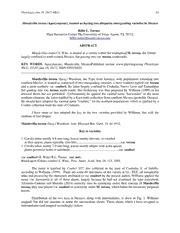
Mandevilla torosa (Apocynaceae), treated as having two allopatric intergrading varieties in Mexico PDF
Preview Mandevilla torosa (Apocynaceae), treated as having two allopatric intergrading varieties in Mexico
Phytologia (Jan 19, 2017) 99(1) 83 Mandevilla torosa (Apocynaceae), treated as having two allopatric intergrading varieties in Mexico Billie L. Turner TX Plant Resources Center The University of Texas Austin, 78712 [email protected] ABSTRACT Mandevilla coulteri S. Wats, is treated as a variety within the widespread M. torosa, the former largely confined to north-central Mexico, but passing into var. torosa southwards. KEY WORDS: Apocynaceae, Mandevilla, MexicoPublished on-line www.phytologia.org Phytologia 99(1): 83-85 (Jan 19, 2017). ISSN 030319430. Mandevilla torosa (Jacq.) Woodson, the Type from Jamaica, with populations extending into southern Mexico, is treated as composed of two intergrading varieties, a more southern typical var. torosa and a more northern var. coulteri, the latter largely confined to Coahuila, Nuevo Leon and Tamaulipas but grading into var. torosa south-wards; this dichotomy was first proposed by Williams (1999) in his doctoral thesis but not published. Unfortunately he applied the varietal name “karwinskii” to the more northern elements, the latter typified by a Karwinski collection from southern Mexico (probably Oaxaca). He should have adopted the varietal name “coulteri,” for the northern populations, which is typified by a Coulter collection from the state of Coahuila. I have more or less adopted the key to the two varieties provided by Williams, but with the addition of leaf shapes: Mandevilla torosa (Jacq.) Woodson, Ann. Missouri Bot. Card. 19: 64 1932. Key to varieties mm 1. Corolla tubes mostly 4-6 long; leaves mostly obovate, or rounded at their apices; plants typically vine-like var. torosa mm 1. Corolla tubes mostly 7-9 long; leaves mostly elliptic with acute apices; plants perennial herbs or subshrubs var. coulteri var. coulteri (S. Wats) B.L. Turner, var. nov. Based upon Echites coulteri S. Wats., Proc. Amer. Acad. Arts 18: 113. 1883. The name is typified by Coulter 957, this collected in the state of Coahuila, S. of Saltillo, according to Williams (1999). There are some 60 specimens of the variety at LL- TEX, all remarkably alike and possessing the characters attributed to var. coulteri by the present author. Williams applied the name var. karwinskii to all of these sheets, largely because he had not examined the type concerned; Alvorado-Cadenas and Morales (2014) correctly note its synonymy under their concept of Mandevilla torosa; they also placed var. coulteri in synonymy under M. torosa, which belies the taxonomy proposed herein. W Distribution of the two taxa in Mexico, along with intermediates, is show in Fig. 1. illiams mapped, but did not annotate or name the intermediate sheets. Those sheets which I have accepted as intermediates (and mapped accordingly) follow: 84 Phytologia (Jan 19, 2017) 99(1) W TAMAULIPAS (two collections): Hidalgo, Hinton et al. 24709', 11 mi of Victoria. Graham & Johnston 4133. SAN LUIS POTOSI: Barkley et al. 854; Irving 167 [both collections near Cd. de Maiz]. QUERETARO: & & (7 sheets, all intermediate) Carranza 930', Carranza Silva 5873a', Fernandez Rzedowski 3425', Rubio 1866, 1250', Sendn 1042; Zannidio & Carranza 6651. Alvorado-Cadenas and Morales (2014) noted two collections of M. torosa from Veracruz that I have not examined. I have mapped these as var. torosa, but these too might be intermediates. Indeed, DNA with analysis it is possible that typical Mandevilla torosa (in Mexico) will be found confined to the Yucatan Peninsula and that intermediates between these and vai\ coulteri are deserving of formal recognition. It should be noted that Morales (1998) stated ''Mandevilla karninskii is closely related to M, torosa but can be recognized by its ver\^ narrowly elliptic (or almost linear) to spatulate leafblades and mucroulate to rarely acute leaf apices, its usually sub-erect habit, and the usually continuous to obscurely moniliform follicles.” He did not clearly delineate the two taxon, either morphologically or geographically, as perceived by Williams, or the present author. LITERATURE CITED Alvarado-Cardenas, L.O. and Morales, J.F. 2014. El gcmro Mandevilla (Apocynaceae: Apocynoideae, Mesechiteae) en Mexico. Botanical Sciences 92: 59-79. A Morales. J.F. 1998. synopsis of the genus Mandevilla (Apoeynaceae) in Mexico and Central America. Brittonia 50: 214-232. A Williams, J.K. 1999. phylogenetic and taxonomic study of the Apocynaceae, subfamily Apocynoideae of Mexico, with a synopsis of subfamily Plumerioideae. Doctoral Diss„ Univ. of Texas, Austin, 546 pp. ACKNOWLEDGEMENTS Thanks to LL-TEX for specimens examined and to Jana Kos for editorial input. Phytologia (Jan 19, 2017) 99(1) 85 Fig. 1. Distribution ofMandevilla torosa in Mexico
